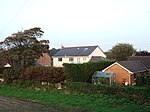Shirdley Hill

Shirdley Hill is a small village in the civil parish of Halsall, Lancashire, England, and is situated on the West Lancashire Coastal Plain. It is reached by B roads from either the A5147 or the A570. An £80,000 redevelopment of the village green, completed in 2009, provided the green with a new pond, benches and a flower bed.Shirdley Hill railway station was on the Liverpool, Southport and Preston Junction Railway, though the station closed in 1938, and the track was lifted in 1964. A plaque on the corner of Shaws Garth marks the site.In 2013, the Village installed an Automated Defibrillator near the Bus Stop. Shirdley Hill gave its name to "Shirdley Hill Sand" which was used in a number of industrial processes, particularly glassmaking.
Excerpt from the Wikipedia article Shirdley Hill (License: CC BY-SA 3.0, Authors, Images).Shirdley Hill
Renacres Lane, West Lancashire Halsall
Geographical coordinates (GPS) Address Nearby Places Show on map
Geographical coordinates (GPS)
| Latitude | Longitude |
|---|---|
| N 53.608 ° | E -2.968 ° |
Address
Renacres Lane
Renacres Lane
L39 8SQ West Lancashire, Halsall
England, United Kingdom
Open on Google Maps









